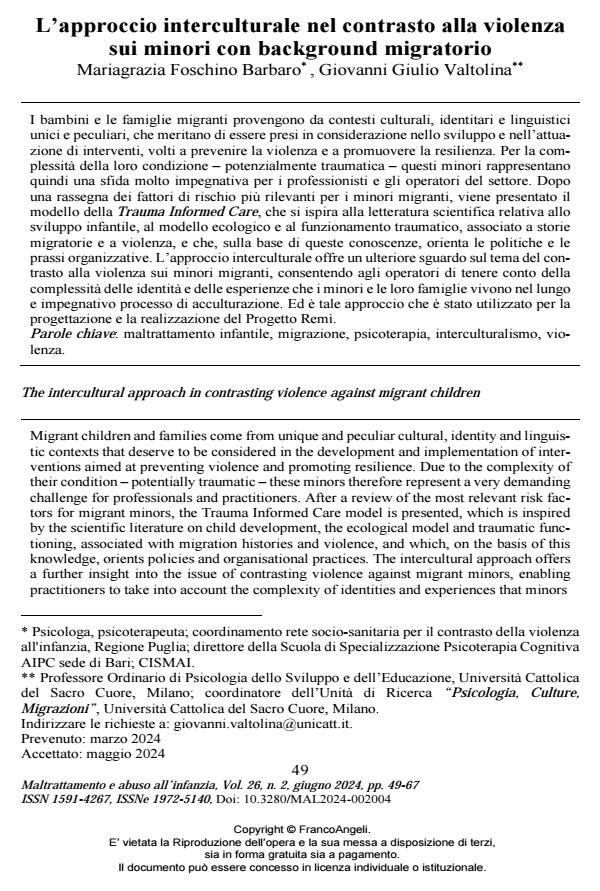L’approccio interculturale nel contrasto alla violenza sui minori con background migratorio
Titolo Rivista MALTRATTAMENTO E ABUSO ALL’INFANZIA
Autori/Curatori Mariagrazia Foschino Barbaro, Giovanni Giulio Valtolina
Anno di pubblicazione 2024 Fascicolo 2024/2
Lingua Italiano Numero pagine 19 P. 49-67 Dimensione file 251 KB
DOI 10.3280/MAL2024-002004
Il DOI è il codice a barre della proprietà intellettuale: per saperne di più
clicca qui
Qui sotto puoi vedere in anteprima la prima pagina di questo articolo.
Se questo articolo ti interessa, lo puoi acquistare (e scaricare in formato pdf) seguendo le facili indicazioni per acquistare il download credit. Acquista Download Credits per scaricare questo Articolo in formato PDF

FrancoAngeli è membro della Publishers International Linking Association, Inc (PILA)associazione indipendente e non profit per facilitare (attraverso i servizi tecnologici implementati da CrossRef.org) l’accesso degli studiosi ai contenuti digitali nelle pubblicazioni professionali e scientifiche
I bambini e le famiglie migranti provengono da contesti culturali, identitari e linguistici unici e peculiari, che meritano di essere presi in considerazione nello sviluppo e nell’attuazione di interventi, volti a prevenire la violenza e a promuovere la resilienza. Per la complessità della loro condizione – potenzialmente traumatica – questi minori rappresentano quindi una sfida molto impegnativa per i professionisti e gli operatori del settore. Dopo una rassegna dei fattori di rischio più rilevanti per i minori migranti, viene presentato il modello della Trauma Informed Care, che si ispira alla letteratura scientifica relativa allo sviluppo infantile, al modello ecologico e al funzionamento traumatico, associato a storie migratorie e a violenza, e che, sulla base di queste cono-scenze, orienta le politiche e le prassi organizzative. L’approccio interculturale offre un ulteriore sguardo sul tema del contrasto alla violenza sui minori migranti, consen-tendo agli operatori di tenere conto della complessità delle identità e delle esperienze che i minori e le loro famiglie vivono nel lungo e impegnativo processo di accultura-zione. Ed è tale approccio che è stato utilizzato per la progettazione e la realizzazione del Progetto Remì. .
Parole chiave:maltrattamento infantile, migrazione, psicoterapia, interculturalismo, violenza
Mariagrazia Foschino Barbaro, Giovanni Giulio Valtolina, L’approccio interculturale nel contrasto alla violenza sui minori con background migratorio in "MALTRATTAMENTO E ABUSO ALL’INFANZIA" 2/2024, pp 49-67, DOI: 10.3280/MAL2024-002004